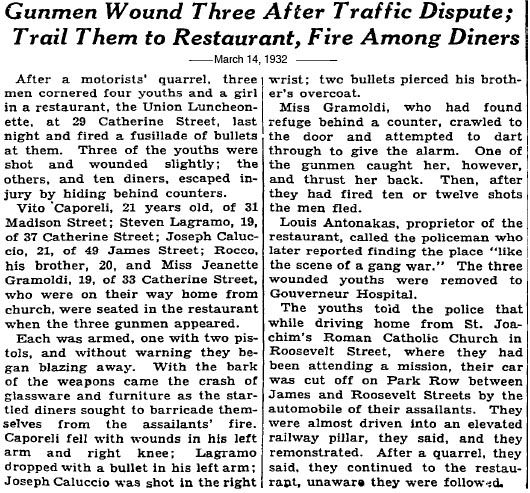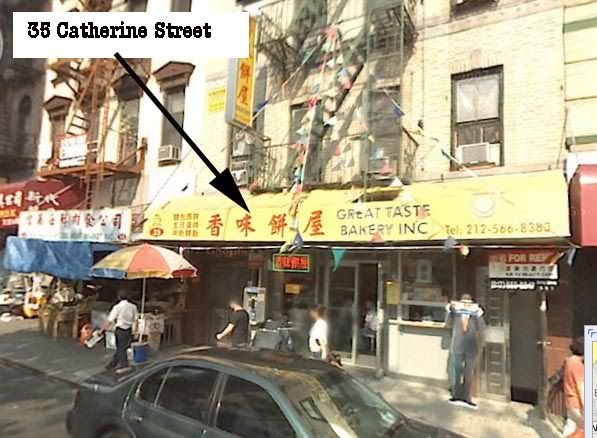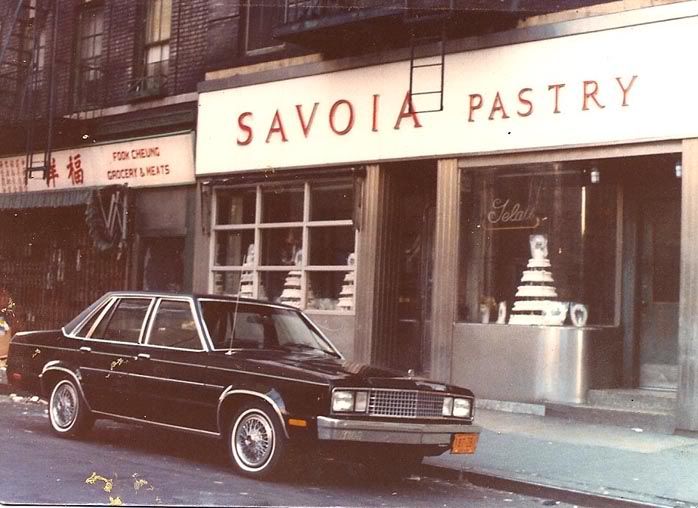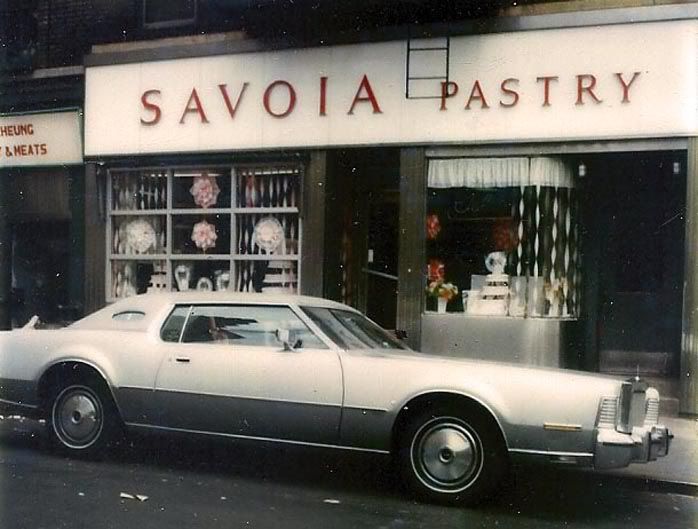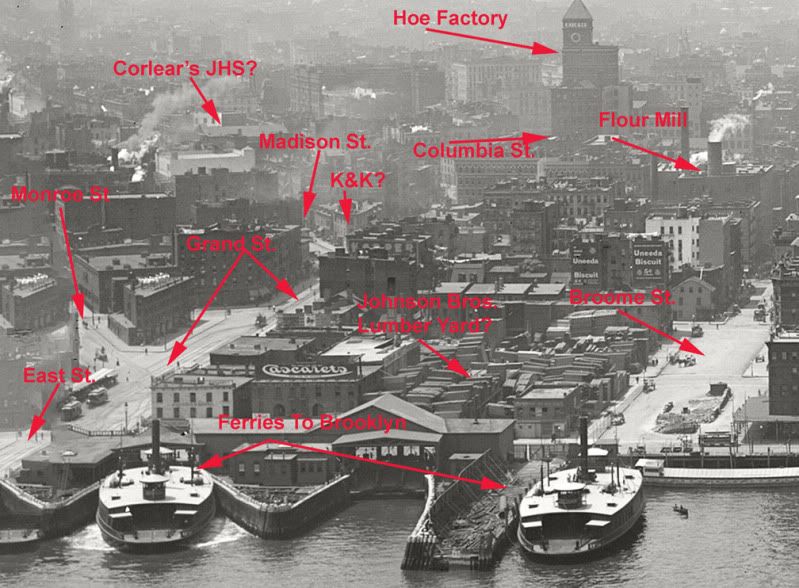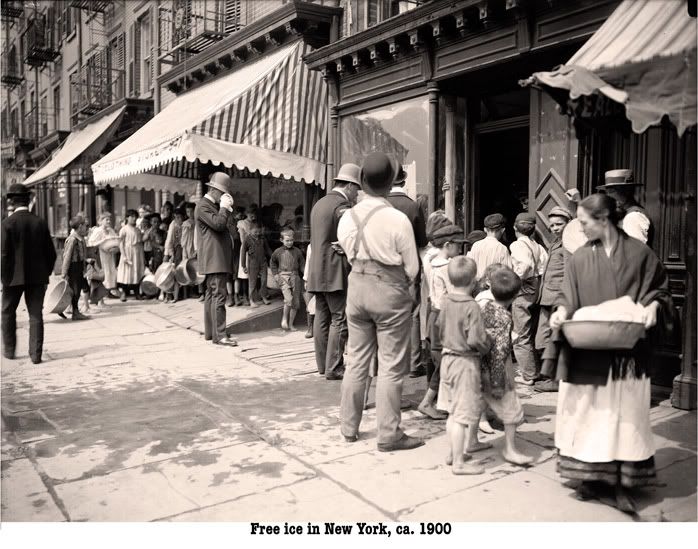Sunday, July 18, 2010
Savoia's Pastry Shop: 35 Catherine Street
I got these from Lisa Zagemi yesterday
She owns:
Made in Heaven Cakes
Custom and Specialty Cakes
530 Third Avenue
Brooklyn, NY 11215
At the KV Reunion back in May, Nancy Sing Bock talked about how special summers were because of
the ices from Savoia
Hi David, It's Lisa, sorry I haven't been in touch. HereLisa carries on the family tradition along with her husband and her sister Francine.
are a few photos my dad, Anthony Favazza, gave me of the front of the bakery. I am going to see if I have see any others. BTW everyone called my dad Sonny.
She owns:
Made in Heaven Cakes
Custom and Specialty Cakes
530 Third Avenue
Brooklyn, NY 11215
At the KV Reunion back in May, Nancy Sing Bock talked about how special summers were because of
the ices from Savoia
Friday, July 16, 2010
Cascarets?
cascarets
I was curious about the Cascarets sign from the 1903 East River photo. Sure enough they were used as a laxative. Boy folks in the early 1900's were very concerned about BM's!. In the above I put together images I found of Cascarets.
I was curious about the Cascarets sign from the 1903 East River photo. Sure enough they were used as a laxative. Boy folks in the early 1900's were very concerned about BM's!. In the above I put together images I found of Cascarets.
1903: East River From The Williamsburg Bridge, Close-Ups
I zoomed in on a higher resolution picture from the previous post to highlight some of the landmarks I could recognize. I used an 1891 map to help.
Joe Petrosino: 2006 Movie Excerpt
from a 2006 Italian made movie
from the youtube poster
In memory of the most important italian-american police agent, he fought against the mafia carrying out his duty up to the end. I know, he isn't famous as well as Al Capone, Lucky Luciano etc. but this is because of the stereotype and the ignorance of many people are very strong when one talks about the italian-american reality and about the mafia.
Little Italy
As long as we're on the subject. Articles I compiled on the history of Little Italy from From the Italian Tribune
Little Italy
Little Italy
Joseph Petrosino: 1905
petrosino-1905
from the ny daily news
from the ny daily news
F. Y. I.: A Hero With a Badge, By MICHAEL POLLAK
Q. I am proud of the Italian heritage of New York police officers, and there is one Italian-American officer I wish you would write about: Joe Petrosino.
A. Gladly. Lt. Giuseppe Petrosino, perhaps the most celebrated individual officer in New York police history, holds a sad distinction: He is the only New York police officer to have been killed in the line of duty outside the United States.
The Mafia violated its longstanding rule against killing cops when in 1909 it silenced Lieutenant Petrosino, who had emigrated at age 13 from Salerno. His specialty was fighting the mob in the days when it was extorting money from immigrants.
Petrosino, often called Joseph, was born in 1860. He joined the force in 1883 and was promoted to detective in 1895 in a departmental housecleaning spurred by Theodore Roosevelt, the police commissioner.
At 5 feet 3 and 200 pounds, Petrosino was not known for his gentleness. In 1902, he founded the Police Department’s bomb squad to counter the mob’s use of explosives in carrying out extortion threats.
From 1905, Petrosino and the “Italian Branch,” an elite corps of Italian-American undercover officers, arrested thousands of members of the Sicilian Mafia and Neapolitan Camorra, deporting 500. Reports of crime against Italian-Americans dropped 50 percent.
Lieutenant Petrosino was shot to death on March 12, 1909, in Palermo, Sicily, where he was planning to record the names of Sicilian criminals who had immigrated to the United States; his goal was to deport them. A local Mafia leader, Don Vito Cascio Ferro, was suspected, but no one was ever convicted of the killing.
Some 250,000 people attended Lieutenant Petrosino’s funeral. He is buried in Calvary Cemetery in West Maspeth, Queens, and his name lives on at Petrosino Square, a triangle at Kenmare and Lafayette Streets in Little Italy, where he grew up.
Joseph Petrosino
petrosino
Joseph Petrosino is a real life character in Laurie Fabiano's Elizabeth Street
Above images related t Petrosino, below his wiki bio
Joseph Petrosino is a real life character in Laurie Fabiano's Elizabeth Street
Above images related t Petrosino, below his wiki bio
Giuseppe "Joe" Petrosino (August 30, 1860 - March 12, 1909) was a New York City police officer who was a pioneer in the fight against organized crime. The various crime fighting techniques that Petrosino pioneered during his law enforcement career are still practiced by various agencies in the fight against crime.
In 1874, the balance of the Petrosino family emigrated to the United States from Padula (in the province of Salerno, Campania), a village in southern Italy. Joseph having been sent over previously with a young cousin (Antonio Puppolo) to live with his Grandfather in New York. An unfortunate street car accident took the life of the Grandfather and the two young cousins wound up in Orphans/Surrogates Court. Rather than send the children to the Orphanage, the Judge took them home to his own family and provided for the boys until relatives in Italy could be contacted and arrangements made to bring over family members. As a consequence Joseph Petrosino and his cousin Anthony Puppolo lived with a "politically connected" Irish Household for some time, which opened up educational and employment avenues which were not always available to more recent immigrants. On 1883-10-19, he joined the NYCPD[1]. During his service, he would become friends with Theodore Roosevelt, who was police commissioner of New York City at the time. On 1895-07-20[1], Roosevelt promoted him to Detective Sergeant in charge of the department's Homicide Division, making him the first Italian-American to lead this division.
The pinnacle of his career came in December 1908[1] when he was promoted to Lieutenant and placed in charge of the Italian Squad, an elite corps of Italian-American detectives specifically assembled to deal with the criminal activities of organizations like the Mafia, which Petrosino saw as a shame to decent Italians.
One notable case in Petrosino's stint with the Italian Squad was when the famous Italian tenor Enrico Caruso, who was performing at the Metropolitan Opera House in New York City, was being blackmailed by gangsters who demanded money in exchange for his life.
It was Petrosino who convinced Caruso to help him catch those behind the blackmail.
A second notable case in Petrosino's stint with the Italian Squad was his infiltration of an Italian-based anarchist organization that assassinated King Umberto I of Italy. During his mission, he discovered evidence that the organization intended to assassinate President William McKinley during his trip to Buffalo.
Petrosino warned the Secret Service, but McKinley ignored the warning, even after Roosevelt, who had by this time become Vice-President of the United States, vouched for Petrosino's abilities. As a result, McKinley was assassinated by Leon Czolgosz during his visit to Buffalo's Pan-American Exposition on September 6, 1901.
Petrosino's investigations into Mafia activities led him to Don Vito Cascio Ferro, the godfather of the Mafia in New York. In 1903, Petrosino arrested him on suspicion of murder, but Cascio Ferro was acquitted. He later returned to Sicily, where he became increasingly involved with the Sicilian Mafia.
In 1909, Petrosino made plans to travel to Palermo, Sicily, on a top secret mission. However, because of the incompetence of Thomas Bingham, New York's police commissioner, the New York Herald published the story of Petrosino's mission on February 20, 1909, just days before his departure. Even though he was aware of the danger, Petrosino headed to Palermo as planned. However, this decision would prove fatal. Petrosino wrongly believed that the Sicilian Mafia would not kill a policeman, as they did not in America.
On March 12, 1909, after arriving in Palermo, Petrosino received a message from someone claiming to be an informant, asking the detective to meet him in the city's Piazza Marina to give him information about the Mafia. Petrosino arrived at the rendezvous, but it was a trap. While waiting for his 'informant,' Petrosino was shot to death by Mafia assassins.
Vito Cascio Ferro was arrested for Petrosino's murder but was released after an associate provided an alibi. However, he later claimed to other crime figures that he had killed Petrosino, which helped propel him into the position of capo di tutti capi (boss of bosses). Ironically Ferro died in prison in 1943 after being arrested in 1927 on a murder charge he probably did not commit.
On April 12, 1909, Petrosino's funeral, which was attended by 250,000 people, was held in Manhattan. New York City declared the day of his burial a holiday to allow its citizens to pay their respects. A small plaza just north of the old NYPD Headquarters at 240 Center Street in Manhattan was renamed in his memory[1]. His widow {B.1869} died in 1957.
* Among the numerous honors, awards and recognitions received includes a small park in Greenwich Village, New York City, formerly known as Kenmare Square, was named after Petrosino in 1987. Lieutenant Joseph Petrosino Square Park as well as the Joe Petrosino Prize for Investigative Reporting which was also named in his honor.
* Petrosino's story would be discussed on the 2-hour History Channel program Godfathers, which featured commentary concerning his life by Mario Cuomo, former governor of New York, and Bernard Kerik, former police commissioner of New York City.
* Three biographical films have been made of Petrosino's life including Sidney M. Goldin's The Adventures of Lieutenant Petrosino (1912) as well as Pay or Die (1960) starring Ernest Borgnine and The Black Hand (1973) starring Lionel Stander. He has also been the subject of the Italian television series Joe Petrosino, where he was portrayed by Beppe Fiorello.
* The character of Lieutenant Louis Lorelli (J. Carrol Naish) in The Black Hand (1950), starring Gene Kelly, is loosely modeled on Petrosino.
* British novelist Frederick Nolan has written two novels based on Petrosino's career with the NYPD, No Place to Be a Cop (1974) and Kill Petrosino! (1975).
Thursday, July 15, 2010
Joe Bruno's Find Big Fat Fanny Fast: Dinner at Forlinis
Find Big Fat Fanny Fast - Dinner at Forlinis
from Joe Bruno who gave me permission to post these chapters on the KV blog.
from Joe Bruno who gave me permission to post these chapters on the KV blog.
I'm writing a spoof novel of the mob in the neighborhood called Find Big Fat Fanny Fast. You can find several first drafts excerpts of Find Big Fat Fanny Fast on my FB wall. The book should be finished in a a few months. It will be available in ebook on the internet and in print a few months later. It can be downloaded to Kindle or any of the other ebook readers. It's much cheaper on ebooks.
Joe Bruno's Find Big Fat Fanny Fast: Dave's Corner
Find Big Fat Fanny Fast - Dave's Corner
from Joe Bruno who gave me permission to post these chapters on the KV blog.
from Joe Bruno who gave me permission to post these chapters on the KV blog.
I'm writing a spoof novel of the mob in the neighborhood called Find Big Fat Fanny Fast. You can find several first drafts excerpts of Find Big Fat Fanny Fast on my FB wall. The book should be finished in a a few months. It will be available in ebook on the internet and in print a few months later. It can be downloaded to Kindle or any of the other ebook readers. It's much cheaper on ebooks.
Joe Bruno's Find Big Fat Fanny Fast: The Russian Baths
Find Big Fat Fanny Fast - The Russian Baths
from Joe Bruno who gave me permission to post these chapters on the KV blog.
from Joe Bruno who gave me permission to post these chapters on the KV blog.
I'm writing a spoof novel of the mob in the neighborhood called Find Big Fat Fanny Fast. You can find several first drafts excerpts of Find Big Fat Fanny Fast on my FB wall. The book should be finished in a a few months. It will be available in ebook on the internet and in print a few months later. It can be downloaded to Kindle or any of the other ebook readers. It's much cheaper on ebooks.
Elizabeth Street: Kidnapping Sites
Below the address of the Scimeca Family in the 1910 census. 2 Prince is just west of the Bowery.
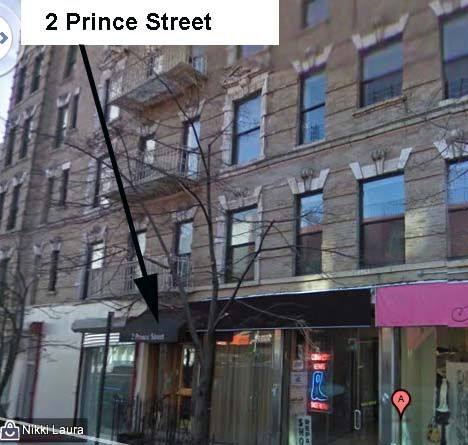
Below the locale of Laurie Fabiano's great grandparents and grandmother in the book Elizabeth Street.

Below the 1910 census record of Laurie Fabiano's great uncle Lorenzo Costas' family. The address was 180 Prince Street. That's between Sullivan and Thompson.
 On Tuesday Laurie mentioned that it was unusual that her family moved to 202 Elizabeth Street. That block was a Sicilian stronghold. Her family was Calabresi. However, the appeal of bathrooms on the floor at 202 Elizabeth Street instead of outhouses on a Calabresi block won out over klan solidarity.
On Tuesday Laurie mentioned that it was unusual that her family moved to 202 Elizabeth Street. That block was a Sicilian stronghold. Her family was Calabresi. However, the appeal of bathrooms on the floor at 202 Elizabeth Street instead of outhouses on a Calabresi block won out over klan solidarity.
The Tenement Museum encyclopedia discusses this

Below the locale of Laurie Fabiano's great grandparents and grandmother in the book Elizabeth Street.

Below the 1910 census record of Laurie Fabiano's great uncle Lorenzo Costas' family. The address was 180 Prince Street. That's between Sullivan and Thompson.

The Tenement Museum encyclopedia discusses this
Little Italies
But many of them did stay, as the numbers above demonstrate, and settled in New York City and the Lower East Side. Italians tended to follow the Irish who had preceded them in both their residential and occupational patterns. They first settled in neighborhoods with some of the oldest housing stock in the city: the notorious Five Points neighborhood between the Brooklyn and Manhattan bridges (today's Chinatown) and the Fourteenth Ward west of the Bowery (today's Little Italy). They then moved north into present-day SoHo and Greenwich Village. Before long a sizeable Little Italy sprouted uptown between 110th and 120th Streets, east of Fourth Avenue. Eventually, East Harlem became the largest Little Italy in all of New York. While Italians were never a majority on the Lower East Side (always under 10 % of the population), their presence grew steadily from the turn of the century through the 1930s.
Within their neighborhoods, Italians tended to settle next to people from the same regions of Italy. Neapolitans tended to dominate Mulberry Street, the Calabresi claimed Mott Street, and Sicilians - who dominated the Italian immigration after 1900 - took over Elizabeth Street. In fact, immigrants from individual Sicilian towns tended to congregate together on different stretches of Elizabeth Street.
Elizabeth Street
scimeca
I heard Laurie Fabiano speaking about her book Elizabeth Street at the Tenement Museum on Tuesday night, June 13th. I've been reading it and it's excellent. The story tells of a kidnapping of a family member by the Black Hand in 1909. The kidnapping didn't make the news, but I found a similar one that occured in 1910. The Scimeca family was the one victimized. Fabiano's family lived at 202 Elizabeth Street. Scimeca's lived around the corner at 2 Prince Street.
I heard Laurie Fabiano speaking about her book Elizabeth Street at the Tenement Museum on Tuesday night, June 13th. I've been reading it and it's excellent. The story tells of a kidnapping of a family member by the Black Hand in 1909. The kidnapping didn't make the news, but I found a similar one that occured in 1910. The Scimeca family was the one victimized. Fabiano's family lived at 202 Elizabeth Street. Scimeca's lived around the corner at 2 Prince Street.
Wednesday, July 14, 2010
Joe Bruno's Find Big Fat Fanny Fast: Chapter One
Find Big Fat Fanny Fast - Chapter One
from Joe Bruno who gave me permission to post these chapters on the KV blog.
from Joe Bruno who gave me permission to post these chapters on the KV blog.
I'm writing a spoof novel of the mob in the neighborhood called Find Big Fat Fanny Fast. You can find several first drafts excerpts of Find Big Fat Fanny Fast on my FB wall. The book should be finished in a a few months. It will be available in ebook on the internet and in print a few months later. It can be downloaded to Kindle or any of the other ebook readers. It's much cheaper on ebooks.
Joe Bruno's Find Big Fat Fanny Fast: JFK Jr. Softball
Jfk Softball
from Joe Bruno who gave me permission to post these chapters on the KV blog.
from Joe Bruno who gave me permission to post these chapters on the KV blog.
I'm writing a spoof novel of the mob in the neighborhood called Find Big Fat Fanny Fast. You can find several first drafts excerpts of Find Big Fat Fanny Fast on my FB wall. The book should be finished in a a few months. It will be available in ebook on the internet and in print a few months later. It can be downloaded to Kindle or any of the other ebook readers. It's much cheaper on ebooks.
Joe Bruno's Find Big Fat Fanny Fast: KV Memories Bob Feller
KV Memories Bob Feller
from Joe Bruno who gave me permission to post these chapters on the KV blog.
from Joe Bruno who gave me permission to post these chapters on the KV blog.
I'm writing a spoof novel of the mob in the neighborhood called Find Big Fat Fanny Fast. You can find several first drafts excerpts of Find Big Fat Fanny Fast on my FB wall. The book should be finished in a a few months. It will be available in ebook on the internet and in print a few months later. It can be downloaded to Kindle or any of the other ebook readers. It's much cheaper on ebooks.
Joe Bruno's Find Big Fat Fanny Fast: Chicken Delight
Kv Memories - Chicken Delight
from Joe Bruno who gave me permission to post these chapters on the KV blog.
from Joe Bruno who gave me permission to post these chapters on the KV blog.
I'm writing a spoof novel of the mob in the neighborhood called Find Big Fat Fanny Fast. You can find several first drafts excerpts of Find Big Fat Fanny Fast on my FB wall. The book should be finished in a a few months. It will be available in ebook on the internet and in print a few months later. It can be downloaded to Kindle or any of the other ebook readers. It's much cheaper on ebooks.
Joe Bruno's Find Big Fat Fanny Fast: Rumble In Columbus Park
Find Big Fat Fanny Fast-- Rumble in Columbus Park
from Joe Bruno who gave me permission to post these chapters on the KV blog.
from Joe Bruno who gave me permission to post these chapters on the KV blog.
I'm writing a spoof novel of the mob in the neighborhood called Find Big Fat Fanny Fast. You can find several first drafts excerpts of Find Big Fat Fanny Fast on my FB wall. The book should be finished in a a few months. It will be available in ebook on the internet and in print a few months later. It can be downloaded to Kindle or any of the other ebook readers. It's much cheaper on ebooks.
Joe Bruno's Find Big Fat Fanny Fast: Mike Maruffi and Bogart
Mike Maruffi and Bogart
rom Joe Bruno who gave me permission to post these chapters on the KV blog.
rom Joe Bruno who gave me permission to post these chapters on the KV blog.
I'm writing a spoof novel of the mob in the neighborhood called Find Big Fat Fanny Fast. You can find several first drafts excerpts of Find Big Fat Fanny Fast on my FB wall. The book should be finished in a a few months. It will be available in ebook on the internet and in print a few months later. It can be downloaded to Kindle or any of the other ebook readers. It's much cheaper on ebooks.
Joe Bruno's Find Big Fat Fanny Fast: The Mayor Of Chinatown
Find Big Fat Fanny Fast - The Mayor of Chinatown
from Joe Bruno who gave me permission to post these chapters on the KV blog.
from Joe Bruno who gave me permission to post these chapters on the KV blog.
I'm writing a spoof novel of the mob in the neighborhood called Find Big Fat Fanny Fast. You can find several first drafts excerpts of Find Big Fat Fanny Fast on my FB wall. The book should be finished in a a few months. It will be available in ebook on the internet and in print a few months later. It can be downloaded to Kindle or any of the other ebook readers. It's much cheaper on ebooks.
Joe Bruno's Find Big Fat Fanny Fast: Chance Meeting in Columbus Park
Find Big Fat Fanny Fast-- Chance Meeting in Columbus Park
from Joe Bruno who gave me permission to post these chapters on the KV blog.
from Joe Bruno who gave me permission to post these chapters on the KV blog.
I'm writing a spoof novel of the mob in the neighborhood called Find Big Fat Fanny Fast. You can find several first drafts excerpts of Find Big Fat Fanny Fast on my FB wall. The book should be finished in a a few months. It will be available in ebook on the internet and in print a few months later. It can be downloaded to Kindle or any of the other ebook readers. It's much cheaper on ebooks.
Tuesday, July 13, 2010
Look Through Any (KV) Window
Look through any window, yeah
What do you see
Smiling faces all around
Rushing through the busy town
Where do they go
Moving on their way
Walkin' down the highways and the byways
Where do they go
Moving on their way
People with their shy ways, and their sly ways
Oh, You can see the little children all around
Oh, You can see the little ladies in their gowns, when you
Look through any window, yeah
Any time of day
See the drivers on the roads
Button down their heavy loads
Where do they go
Moving on their way
A driving down the highways, and the byways
Where do they go
Moving on their way
Drivers with their shy ways, and their sly ways
Oh, You can see the little children all around
Oh, You can see the little ladies in their gowns, when you
Look through any window, yeah
What do you see
Smiling faces all around
Rushing through the busy town
Where do they go
Moving on their way
Moving on their way
Moving on their way
I Am Javy, I'm Your Starter
The season's long
With many a winding turn
That leads us to who knows where
Who knows where
But I am strong
Strong enough to carry them
I am Javy, I'm your starter
So on we go
Yank welfare is of my concern
No burden I cannot bear
We'll get there
For I know
Lean run support will not encumber me
I am Javy, I'm your starter
If I'm laden at all
I'm laden with sadness
That everyone thought
I would pitch with madness
like I did before in 2004
It's a long, long road
From which there is no return
While we're on the way to there
Be aware
I'll shoulder the load
It won't weigh me down at all
Cause I am Javy, I'm your starter
I Am Javy
I am Javy, I'm your starter
Jazz On A Summer's Day: 1958
from Alan Kurtz
Looking like a grande dame in Vogue, singing like a dame outa Down Beat, Anita O'Day walked away with Jazz on a Summer's Day (1960). The documentary of 1958's Newport Jazz Festival should have been called Jazz on a Summer's O'Day."I was scheduled for 5 o'clock in the afternoon," Miss O'Day recounts in her autobiography, "and I asked myself what to wear. 'It's teatime,' I told the Italian lady who ran a dress shop in Greenwich Village. She brought out this black dress, trimmed with white. We both knew it was right, but I asked what I could wear on my head. She went into the back room and came out with a black cartwheel, trimmed with white feathers. Both went with my see-through, plastic pumps and for a fun touch I added short white gloves."After flicking mud from an earlier rain off her shoe, a tightly hemmed Anita wriggled on stage and squinted at the crowd. "Performing in the afternoon was a bonus," she recalled, "because I could see the audience. I spotted Chris Connor out there." Like O'Day, Connor had served a stretch as Stan Kenton's vocalist. "That was good," Anita thought, "because I can make my performance the way I want it to be when I know some of the audience digs what I'm doing and I can relate to them." She related with what amounts to a clinic on jazz singing, in particular wowing the crowd with her up-tempo take on the 1925 chestnut "Tea for Two." Blazing through the lyrics, Anita treats both melody and rhythm to a complete makeover, exercising the unbridled flair of an interior decorator given carte blanche by a client with deep pockets. Following a short piano solo, Anita switches to scat, trading fours with Poole's wire-brushed drums. To conclude, Anita amuses the audience by exchanging wordless quotes with her trio from "Flip Top," a favorite '50s TV jingle. "You get a lot to like with a Marlboro," the original assured. "Filter, flavor, flip-top box." In those halcyon days, cigarette jingles were considered harmless fun. Fifty years later, coffin-nail jingles are thankfully a thing of the past. Anita O'Day, though, is as much fun as ever.
Sunday, July 11, 2010
Chamberlain, That's He
Did 4th Warder Jimmy Durante learn this old ditty from 4th Warder Al Smith?


Who is the man whose bad tosses will bring a loss?
Chamberlain, That's He!
Who will surely fold when your team needs a hold?
Chamberlain, That's He
For he isn't as proud of his name you see,
As a Sparky, Goose, or a Mo, could be.
Who is the man that blows a lead every time he can?
Chamberlain, That's He
C-H-AMBER-L-A-I-N spells Chamberlain
Proud of all the Indian blood that's in he; Many a man can say a word agin he.
C-H-AMBER-L-A-I-N, you see,
Is a name that shame is usually been connected with, Chamberlain, That's he!
C-H-AMBER-L-A-I-N spells Chamberlain
Proud of all the Indian blood that's in he; Many a man can say a word agin he.
C-H-AMBER-L-A-I-N, you see,
Is a name that shame is usually been connected with, Chamberlain, That's he!
Tuesday, July 6, 2010
The Pajama Game: Steam Heat
I've got ::cling cling:: fsssss steam heat.
I've got ::cling cling:: fsssss steam heat.
I've got ::cling cling:: fsssss steam heat.
But i need your love to keep away the cold.
I've got ::cling cling:: fsssss steam heat.
I've got ::cling cling:: fsssss steam heat.
I've got ::cling cling:: fsssss steam heat.
But i can't get warm without your hand to hold.
The radiators hissin still I need your kissin to keep me from freezing each nite.
I've got a hot water bottle, but nothing i've got'll take the place of you holdin me tight.
I've got ::cling cling:: fsssss steam heat.
I've got ::cling cling:: fsssss steam heat.
I've got ::cling cling:: fsssss steam heat.
But i need your love to keep away the cold.
:::Instrumental:::
They told me to throw some more coal in the boiler.
They told me to throw some more coal in the boiler.
They told me to throw some more coal in the boiler.
But that don't do no good.
They told me to pour some more oil in the burner.
They told me to pour some more oil in the burner.
They told me to pour some more oil in the burner.
But that don't do no good.
Coal in the boiler. No good. Oil in the burner. No good. Cold? NO! Hot?
YES! sssssss yes yes yes come on union get hot!!
:::Clapping:::
BOINK BOINK!! BOINK BOINK!! BOINK BOINK!!
:::Instrumental:::
I need your love to keep away the cold. i need you looove to keep awayyyy the colddd....fsss YEA!!
Monday, July 5, 2010
Docks Of New York
Docks of New-York (piano) from Musashi on Vimeo.
The Docks of New York (1928 film) is a silent film starring George Bancroft, Betty Compson, Olga Baclanova, Clyde Cook, and Mitchell Lewis. The ship on which Bill Roberts is a stoker has just put into port, giving the crew one night ashore. The ship's bad-tempered third engineer orders the stokers to clean up, while the engineer heads for a dockside bar, where he has a confrontation with the wife he had abandoned. Then, as Bill himself goes ashore, he sees a young woman attempt to drown herself. Bill dives in, saves her, and then, assisted by the engineer's wife, sees that she is cared for. Bill and the rescued woman begin to enjoy one another's company, but they must contend with the malice of the engineer, as well as a number of other complications.
Directed by Josef von Sternberg, The Docks of New York remains frequently cited by critics as one of the great silent films. The dark, gritty beer-hall ambiance remains a startling visual treat for modern audiences and the superb acting was acclaimed as a benchmark.
The movie was adapted by Jules Furthman from the John Monk Saunders story The Dock Walloper. In 1999, the film was deemed "culturally historically, or aesthetically significant" by the United States Library of Congress and selected for preservation in the National Film Registry.
We're Having A Heat Wave
from the youtube description
You probably could not find two more disparate females than Ella Fitzgerald and Marilyn Monroe, and yet they MET (see video), and in a small way, Marilyn even helped Ella get a gig she couldn't get before, at the famous Mocambo in Los Angeles (Marilyn was a huge fan of Ella's and promised The Mocambo she would sit in the front row every night if they booked Ella for a week...and they did just that in 1955). Ella became the first black performer at The Mocambo, and this incident even prompted Bonnie Geer, a London-based American playwright, to recently write a play about the two entitled "Marilyn and Ella". The song "Heat Wave" was composed by Irving Berlin in 1933 originally for the Broadway musical "As Thousands Cheer" starring Ethel Merman. In 1954, the song was reprised in the motion picture "There's No Business Like Show Business" also starring Ethel Merman along with Marilyn Monroe who famously sang this Berlin tune in the film. Ella subsequently recorded it for Verve, and I wonder if Marilyn was on her mind when she sang it.
We're having a heat wave,
A tropical heat wave,
The temperature's rising,
It isn't surprising,
She certainly can can-can.
She started a heat wave
By letting her seat wave
In such a way that
The customers say that
She certainly can can-can.
Gee, her anatomy
Makes the mercury
Jump to ninety-three.
We're having a heat wave,
A tropical heat wave,
The way that she moves
That thermometer proves
That she certainly can can-can
Heat Wave
"Heat Wave" is a 1963 hit single by Holland-Dozier-Holland made popular by Motown girl group Martha and the Vandellas on the Gordy (Motown) label and later by Rock vocalist Linda Ronstadt from her Platinum 1975 album Prisoner In Disguise. It is sometimes called "(Love Is Like A) Heat Wave," although that was not the title on the 1963 single.
The song was one of several tunes written and produced by the fabled Holland-Dozier-Holland songwriting and producing team. "Heat Wave" was the second hit collaboration between the Vandellas and H-D-H, the first being "Come and Get These Memories". The lyrics feature the narrator singing about a guy that has her heart "burning with desire" and "going insane" over the feeling of his love.
Produced and composed with a gospel backbeat, jazz overtones and, doo-wop call and responsive vocals, "Heat Wave" was one of the first songs to exemplify the style of music later termed as being the "Motown Sound". The single was a breakthrough hit, peaking at number four on the Billboard Pop Singles Chart, and at number-one on the Billboard R&B Singles Chart.[2]. It also garnered the group's only Grammy Award nomination for Best R&B Vocal Performance by a Duo or Group for 1964, making The Vandellas the first Motown group ever to receive a Grammy Award Nomination.
Martha Reeves, an Alabama-born and Detroit-reared teenager, was brought up in the church by her grandfather. While going to school at Detroit's Northeastern High School, she was vocally coached by Abraham Silver, a man who also vocally coached future Supremes members Florence Ballard and Mary Wilson and Miracles member Bobby Rogers. In 1957, the sixteen-year-old Reeves joined fifteen-year-olds Gloria Williams and Rosalind Ashford and fourteen-year-old Annette Beard to form The Del-Phis. The group spent around four years performing in talent shows, high school parties and private events and being trained by future Motown groomer Maxine Powell at Detroit's dance hall, the Ferris Center. During group detours, Reeves formed the Sabre-Ettes and joined the Fascinations before returning back to the Del-Phis who were now recording backup for Detroit musician Mike Hanks
After performing at several talent shows, the group was signed to the Chess subsidiary, Checkmate Records, with the release of the record, the Reeves-led "I'll Let You Know", which was released in 1961. Gaining some attention from Motown after the label bought Checkmate, the group, now under the name The Vels, recorded the Williams-led song "There He Is (At My Door)" while another Detroit singer, Saundra Mallett (future member of Motown group The Elgins), sung on "Camel Walk", the latter on the Tamla label. After those two singles failed to chart, Williams left the group and the group stopped recording while Reeves bided her time working at odd jobs and tended time singing solo at Detroit nightclubs trying to get noticed, usually under the pseudonym Martha LaVaille.
While performing solo at Detroit's Twenty Grand club, Reeves was asked by Motown executive and staff songwriter/producer William "Mickey" Stevenson to come to the label to audition. Reeves unexpectedly took the job of secretary at the label after showing up to audition on the wrong day. Around this time, Martha and her former Vells bandmates Ashford and Beard were recruited to perform background work for Marvin Gaye on his second album, That Stubborn Kinda Fellow. Gaye's first hit records "Stubborn Kind of Fellow", "Hitch Hike" and "Pride and Joy", prominently featured the girls.
In 1962 when Mary Wells missed a recording session to record a song Stevenson had written, he recruited Reeves to sing the song as a demo. Bringing along Ashford and Beard, the trio recorded Stevenson's "I'll Have to Let Him Go". A strong response from the song convinced Motown founder Berry Gordy to sign the Vels to another Motown subsidiary, Gordy, as a professional recording act, on September 21, 1962 after which Martha changed the group's name.
The story about the name change (to Martha and the Vandellas) is a most colorful one. The Van part came from a street that neighbored Reeves' own - Van Dyke Street in Detroit - and the Della part honored Della Reese, Reeves' favorite singer and a Detroit native herself.
Whenever I'm with him
Something inside
Starts to burnin'
And I'm filled with desire
Could it be the devil in me
Or is this the way love's supposed to be
Just like a heatwave
Burning in my heart
Can't keep from cryin'
It's tearing me apart
Whenever he calls my name
So slow, sweet and plain
I feel, yeah, yeah, well I feel that burning flame
Has my blood pressure got a hold on me
Or is this the way love's supposed to be
Just like a heatwave
Burning in my heart
Can't keep from cryin'
It's tearing me apart
Sometimes I stare in space
Tears all over my face
I can't explain it, don't understand it
I 'ain't never felt like this before
But that doesn't mean it has me amazed
I don't know what to do, my head's in a haze
Just like a heatwave
Burning in my heart
Can't keep from cryin'
It's tearing me apart
Don't pass up this chance
This time it's a true romance
Heatwave
Sunday, July 4, 2010
Railroad Piers Of New York
from railroad piers of Manhattan
Pier 26 was the pier on Catherine Street. Go to page 46-7 of the document.
Railroad Piers New York
Pier 26 was the pier on Catherine Street. Go to page 46-7 of the document.
Railroad Piers New York
Dov'è Peter Panto?
Stand Up Guy-panto
The murder of Panto was a key event in Nathan Ward's Dark Harbor
About Panto, from italianrap
The murder of Panto was a key event in Nathan Ward's Dark Harbor
About Panto, from italianrap
Peter Panto was a longshoreman working the Red Hook docks of Columbia St, Brooklyn when he led a rank-and-file revolt against the corrupt union leadership of Joseph Ryan and mafioso boss Albert Anastasia. On a hot July night, Panto was lured from his home & disappeared. The area's working people covered the walls and sidewalks with the simple phrase "Dov'è Peter Panto?" Arthur Miller's screenplay The Hook on Panto's life & death was never produced; I've always envisioned John Turturro in the leading role. Watch excerpts from the Calandra Institute's 2001 symposium on Panto.
4th Of July Special: The House I Live In
with the original lyrics written by Abel Meeropol, aka Lewis Allen.
What is America to me?on a previous post of a Sinatra version of this song Mike Meeropol commented about his father's displeasure with deleted lyrics
A name, a map or a flag I see,
A certain word, "Democracy",
What is America to me?
The house I live in,
The friends that I have found,
The folks beyond the railroad
and the people all around,
The worker and the farmer,
the sailor on the sea,
The men who built this country,
that's America to me.
The words of old Abe Lincoln,
of Jefferson and Paine,
of Washington and Jackson
and the tasks that still remain.
The little bridge at Concord,
where Freedom's Fight began,
of Gettysburg and Midway
and the story of Bataan.
The house I live in,
my neighbors White and Black,
the people who just came here
or from generations back,
the town hall and the soapbox,
the torch of Liberty,
a home for all God's children,
that's America to me.
The house I live in,
the goodness everywhere,
a land of wealth and beauty
with enough for all to share.
A house that we call "Freedom",
the home of Liberty,
but especially the people,
that's America to me.
Just a note about my dad's lyrics for the HOUSE I LIVE IN. As viewers of the documentary Strange Fruit know, my father was not very pleased that in the Frank Sinatra version of "HOUSE" a line:
"my neighbors white and black" was deleted from the song (it's in the Paul Robeson version of it ... someone told me a Josh White version also has that line) ...
In 1945, a song that celebrated "all races and religions" in a generic way was okay but no specific mention of black equality. Also, the group of kids in the film version were all white -- they were chasing a kid whose "religion" they didn't like!
Friday, July 2, 2010
Thursday, July 1, 2010
I Cover The Waterfront
Last night's Tenement Talk featured Nathan Ward speaking about his new book, Dark Harbor.. Kevin Baker, a special FOKV, lead the discussion. I highly recommend Ward's book. Though concentrating mostly on the west side docks as portrayed in On The Waterfront, Ward's story includes the east side docks that were so close to Knickerbocker Village and the fourth ward. Back in the 1930's-50's this area was largely influenced by Joseph "Socks" Lanza. I was going to ask a question about the rumor that the Normandie's 1943 sinking was actually the work of mobsters looking to subsequently gain a government alliance to offer sabotage protection. This was referred to in Joe Bruno's spoof of Fulton Fish Market history. However, this obnoxious guy asked first. Both Ward and panelist member T.J. English answered that the rumor was false. Below an excerpt from a review of the book from the nypost
Inside New York's 'Waterfront' mob, By GINGER ADAMS OTISPS, I wonder if any of the Fulton Street workers shown in the slide slow may have been neighborhood residents.
In the decades surrounding World War II, corruption flowed as freely as oily water on the waterfronts of Red Hook, Jersey City and lower Manhattan.
Headed by charming “president-for-life” Joe Ryan, the International Longshoremen’s Association ran the piers, the mobs ruled the union, and both fed off the blue-collar dock hands who had no choice but to offer kickbacks so they would get jobs during “the shape,” the daily bruising line-up for work.
Until one oppressively hot night in 1951, when a socially progressive Jesuit priest named John M. Corridan crossed the Hudson River to the New Jersey docks. There, in the heart of Charlie “The Jew” Yanowsky’s mob territory on Labor Day, Corridan preached against the festering corruption that polluted the harbor.
“I suppose some people would smirk at the thought of Christ in the shape,” Corridan said, kicking off a sermon that would become known as “Christ on the Waterfront.”
His audience — a hardboiled bunch of union bosses and longshoremen who assembled at the local Knights of Columbus hall — stirred in their seats.
“It is about as absurd as the fact that He carried carpenter’s tools in His hands and earned His bread by the sweat of His brow. As absurd as the fact that Christ redeemed all men irrespective of their race, color, or station in life.”
Picture Christ burdened by “bread and butter and meat bills and rent” in the morning cattle call, Corridan urged the astounded dockhands, who’d never heard anyone make their distaste of the mob-run dock system so plain.
Jesus “stands in the shape knowing that all won’t get work, and maybe He won’t. He works on a certain pier. He knows that He is expected to be deaf, dumb and blind if He wants to work . . . Christ works on a pier, and His back aches because there are a fair number of ‘boys’ on the pier. They don’t work, but they have their rackets at which so many wink.
“You want to know what’s wrong with the waterfront? It’s love of a lousy buck, whether it’s one or a thousand or ten thousand,” he thundered. “God or no God, a man is going to get them in any way he can. In many ways, you can’t blame the mob.”
Corridan would be immortalized as Karl Malden’s crusading priest in Elia Kazan’s 1954 classic “On the Waterfront.” But long before Marlon Brando coulda been a contender, the corruption of New York City’s waterfront was real — and it took decades, journalist Nathan Ward explains in his riveting “Dark Harbor,” for a collection of brave informers and journalists to force authorities to make more than a token effort to clean it up.
To work on New York’s docks was to face death daily, if not from the potentially fatal work of hauling in cargo from waiting ships — which regularly cost longshoremen fingers, legs and arms — then from the dangers of running afoul of brutal mob enforcers and their union stooges.
Brutal mob bosses like “Socks” Lanza, Louis “Lepke” Buchalter, Meyer Lansky and syndicate killers like Albert “Mad Hatter” Anastasia and his brother Anthony “Tough Tony” had infiltrated the lucrative dock unions and ruled with impunity.
Anastasia, like Lanza, was an Italian-born immigrant who arrived in New York with nothing and quickly found his home on the waterfront. Technically he worked for the ILA — but in reality he was a mob killer, with ties to many of the men who would eventually become leaders of New York’s “Five Families.”
Subscribe to:
Posts (Atom)

